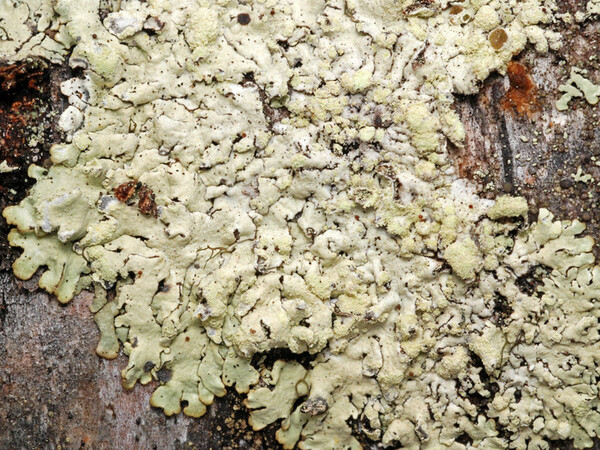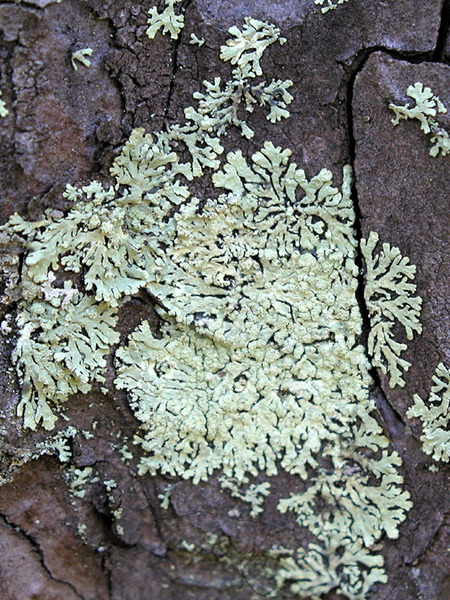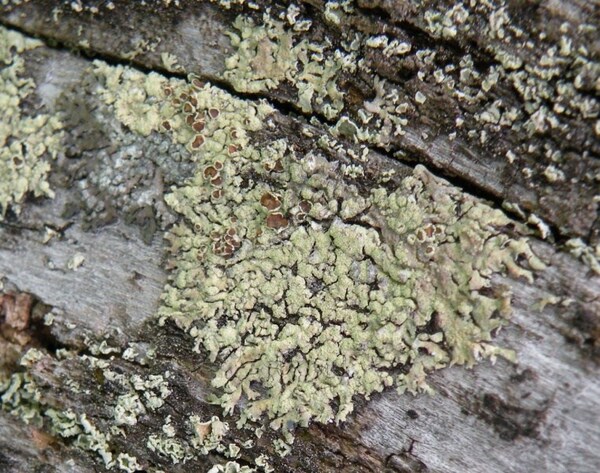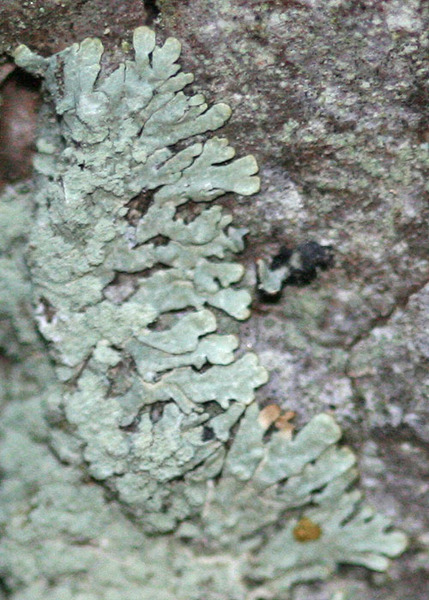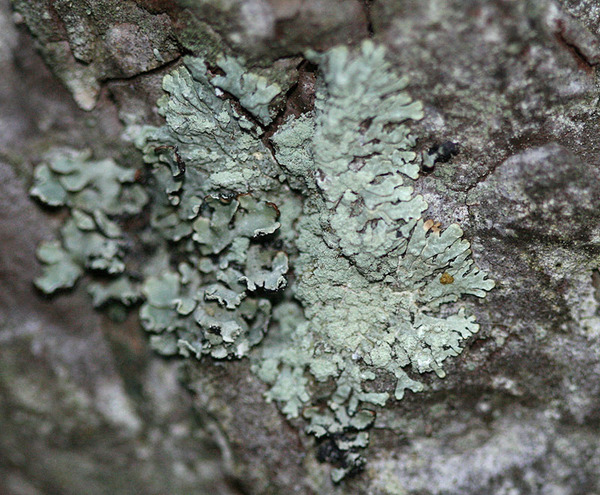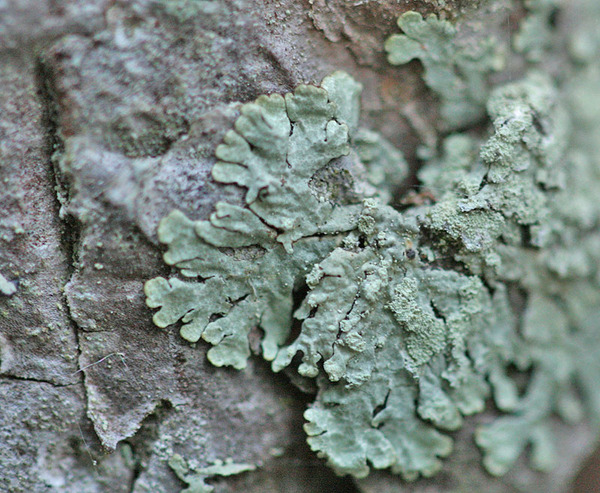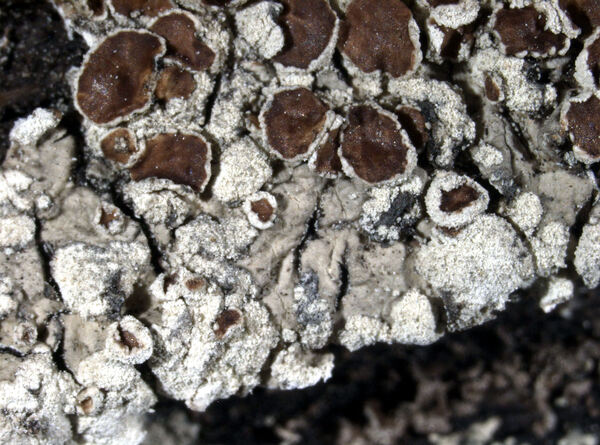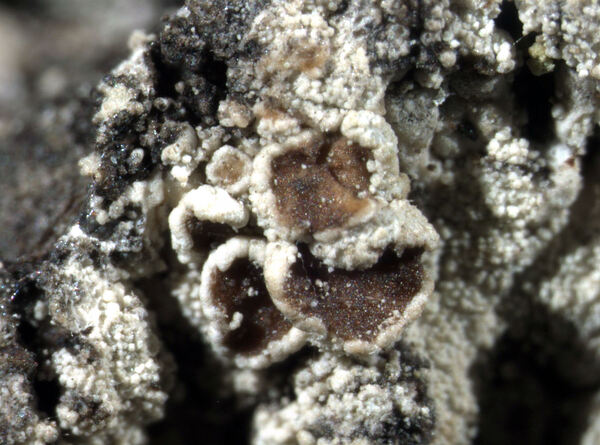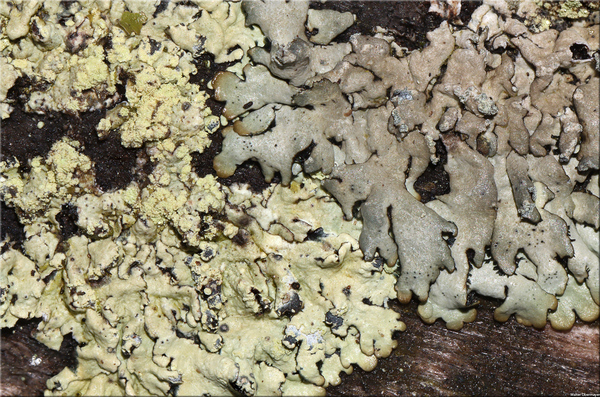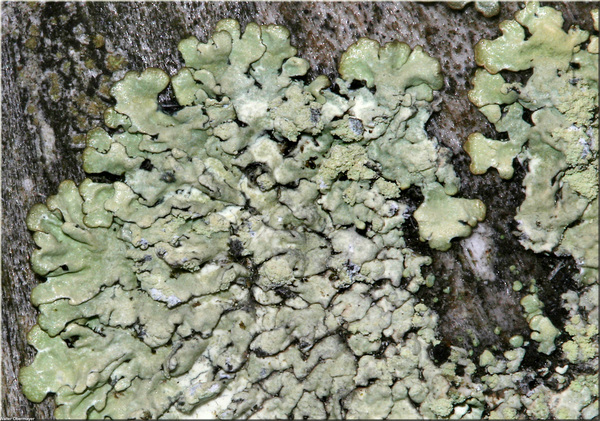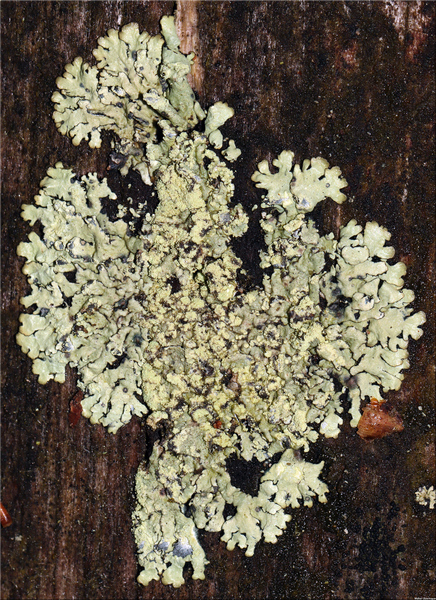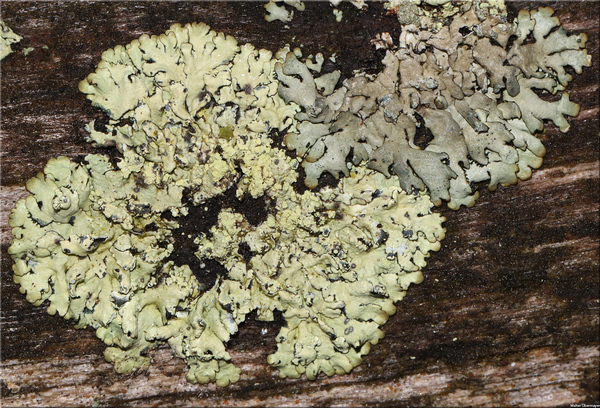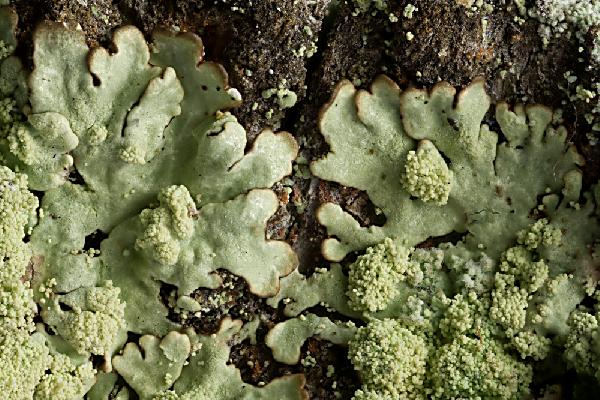Parmeliopsis ambigua (Hoffm.) Nyl.
Syn. Meth. Lich., 2: 54, 1863. Basionym: Squamaria ambigua Hoffm. - Descr. Pl. Cl. Crypt., 2, 24: 56, 1794.
Synonyms: Foraminella ambigua (Hoffm.) S.L.F. Mey.; Imbricaria diffusa auct.; Parmelia ambigua (Hoffm.) Ach.; Parmelia diffusa auct. non (Hoffm.) Sandst.; Parmelia diffusa var. ochromatica Wallr.; Parmelia subsoredians Nyl.; Parmeliopsis diffusa auct.; Parmeliopsis subsoredians (Nyl.) Nyl.
Distribution: N - Frl (Stofer 2006, Tretiach & Molaro 2007, Tomasi 2007), Ven (Nimis 1994, Nascimbene & Caniglia 1997, 2000b, 2002c, 2003c, Caniglia & al. 1999, Nascimbene 2005c, 2008, 2008c, 2011, Nascimbene & al. 2006e, 2009c, 2013b, Nascimbene & Marini 2007, Brackel 2013), TAA (Nascimbene & Caniglia 2000b, 2002c, Caniglia & al. 2002, Nascimbene 2003, 2005b, 2006b, 2006c, 2008b, 2014, Gottardini & al. 2004, Nascimbene & al. 2005, 2006, 2006e, 2007b, 2008c, 2009, 2010, 2014, Stofer 2006, 2022, Thor & Nascimbene 2007, Lang 2009, Brackel 2013, Nascimbene & Marini 2015, Nimis & al. 2015, Trindade & al. 2021), Lomb (Rivellini 1994, Alessio & al. 1995, Arosio & Rinaldi 1995, Zocchi & al. 1997, Arosio & al. 2003, Valcuvia & al. 2003, Dalle Vedove & al. 2004, Nascimbene & al. 2006e, Brackel 2013, Gheza & al. 2015, 2023, Gheza 2019, 2019b), Piem (Caniglia & al. 1992, Morisi & Sereno 1995, Arosio & al. 1998, Isocrono & Falletti 1999, Piervittori 2003, Isocrono & al. 2004, 2006, Morisi 2005, Isocrono & Piervittori 2008, Motiejunaitè & Grochowski 2014), VA (Borlandelli & al. 1996, Piervittori & Isocrono 1997, 1999, Valcuvia & al. 2000b, Piervittori & al. 2001, Revel & al. 2001, Ghiraldi 2003, Isocrono & al. 2005, Matteucci & al. 2008, 2008c, Isocrono & al. 2008, Loppi 2014, Lich. Ital. Exs. 64: Isocrono & al. 2022), Emil (Tretiach & al. 2008, Fariselli & al. 2020), Lig (Brunialti & al. 1999, Giordani & al. 2002, Brunialti & Giordani 2003, Giordani 2006, Watson 2014, Ravera & al. 2022b). C - Tosc (Loppi & al. 1994, Tretiach & Nimis 1994, Benesperi & al. 2007, Tretiach & al. 2008, Benesperi 2011, Brackel 2015, Frati & Brunialti 2023), Marc (Nimis & Tretiach 1999), Umb (Ravera 1998, Ravera & al. 2006), Abr (Nimis & Tretiach 1999, Corona & al. 2016), Sar (Nöske 2000, Neuwirth 2018). S - Camp (Aprile & al. 2003b, Garofalo & al. 2010), Bas, Cal (Puntillo 1996, Incerti & Nimis 2006), Si (Grillo & Caniglia 2004, 2006).
Description: Thallus foliose, heteromerous, dorsiventral, very closely attached, forming orbicular, regular, up to 3 cm wide rosettes that often coalesce to cover much wider surfaces. Lobes radiating, contiguous, flat, 0.5-0.8(-1.5) mm wide, sublinear, irregularly dichotomously branched, greenish yellow, often pale brown at margins and lobe tips, dull, smooth, with powdery, yellowish green soredia in well-delimited, circular, laminal soralia which sometimes coalesce into a continuous sorediate crust. Lower surface gradually darkening from a narrow, brown marginal zone to dark brown or black in the center, with sparse, usually simple rhizines. Upper cortex 10-20 µm thick, of tightly packed, anticlinally oriented hyphae, with a pored epicortex, the cell walls with isolichenan; medulla white; algal layer continuous; lower cortex of hyphae running parallel to the surface. Apothecia very rare, lecanorine, 1-2 mm across, with a brown disc and a sorediate thalline margin. Epithecium brown; hymenium and hypothecium colourless. Asci 8-spored, clavate, Lecanora-type. Ascospores 1-celled. hyaline, ellipsoid, 6.5-13 x 1.5-3(-5) µm. Pycnidia rare, with richly branched, Psora-type conidiophores. Conidia filiform, 12-18(-22) x 0.5-1 µm. Photobiont chlorococcoid. Spot tests: upper cortex K- or K+ (rarely) faintly yellow, C-. KC+ yellow, P-, UV-; medulla P-, K-, KC-, C-, UV+ white. Chemistry: upper cortex with usnic acid (major) and rarely atranorin (minor or trace); medulla with divaricatic acid (major) and nordivaricatic acid (minor).Note: a mainly boreal-montane, circumpolar lichen found on basal parts of trunks, especially of conifers, with a long snow-lie; common in the Alps, especially in the subalpine belt, becoming much rarer in the Apennines, where it was often found in Castanea-woodlands of the montane belt.
Growth form: Foliose, narrow lobed
Substrata: bark
Photobiont: green algae other than Trentepohlia
Reproductive strategy: mainly asexual, by soredia, or soredia-like structures (e.g. blastidia)
Commonnes-rarity: (info)
Alpine belt: extremely rare
Subalpine belt: extremely common
Oromediterranean belt: absent
Montane belt: rather rare
Submediterranean belt: extremely rare
Padanian area: absent
Humid submediterranean belt: extremely rare
Humid mediterranean belt: absent
Dry mediterranean belt: absent
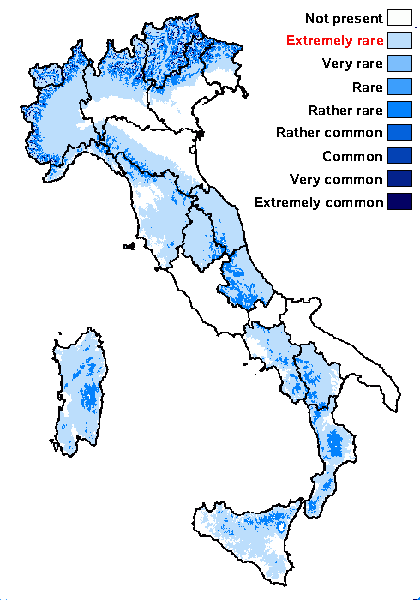
Predictive model
Herbarium samples
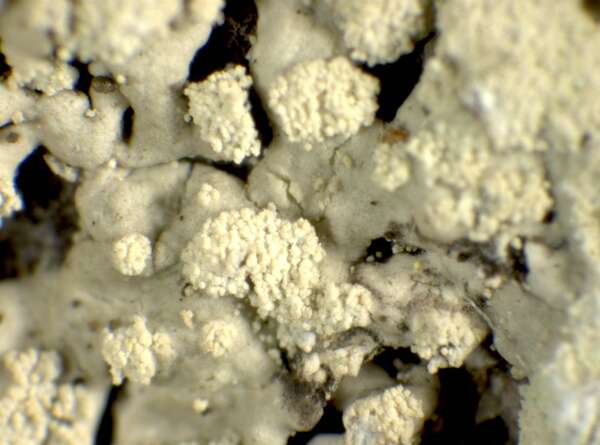

P.L. Nimis; Owner: Department of Life Sciences, University of Trieste
Herbarium: TSB (33030)
2001/12/10
soralia
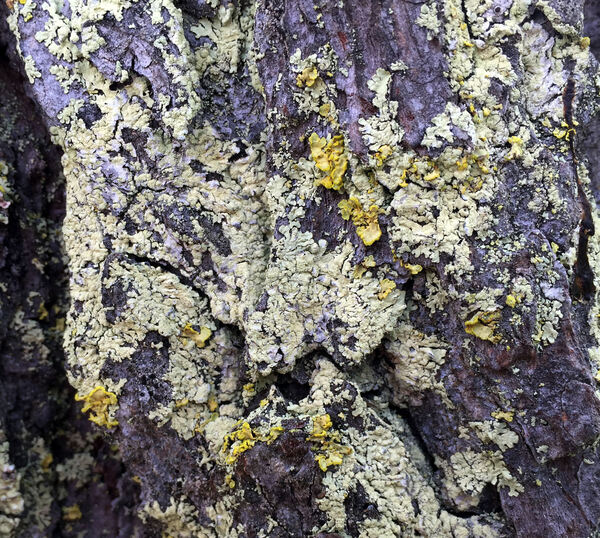

P.L. Nimis; Owner: Department of Life Sciences, University of Trieste
Italy, Friuli Venezia Giulia, Udine, Passo del Pura, Ampezzo Carnico, 1400 m
09.09.2016
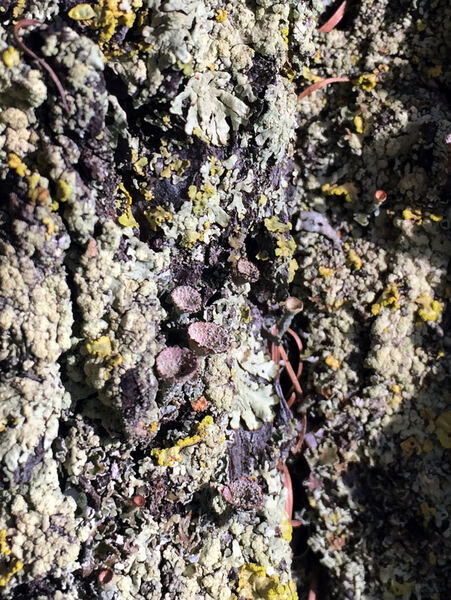

P.L. Nimis; Owner: Department of Life Sciences, University of Trieste
Italy, Friuli Venezia Giulia, Udine, Passo del Pura, Ampezzo Carnico, 1400 m
09.09.2016
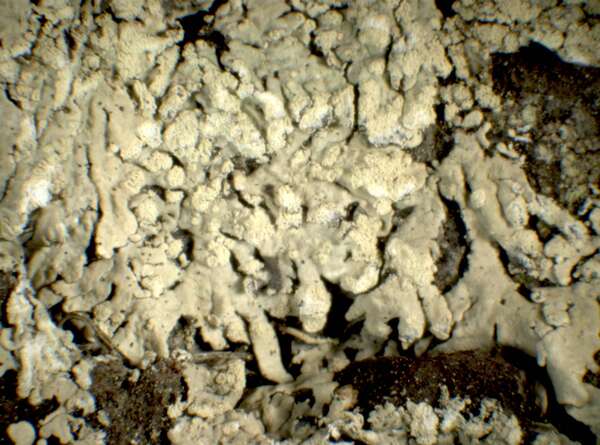

P.L. Nimis; Owner: Department of Life Sciences, University of Trieste
Herbarium: TSB (33030)
2001/12/10
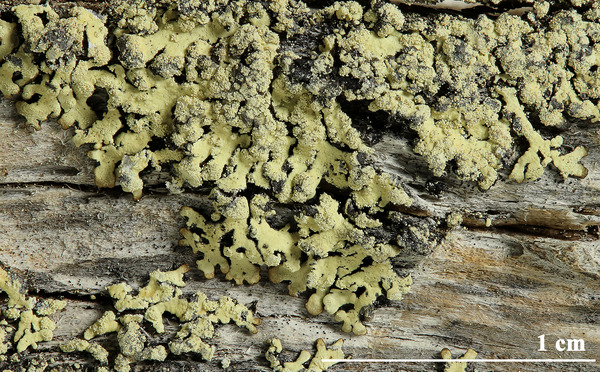

Felix Schumm - CC BY-SA 4.0
[19110], Australia, Victoria, Pretty Valley, Alpine National Park, 18 km south-south-east of Mt. Beauty, 36°53' S, 147°14' E, 1600 m, growing on base of dead Eucalyptus in open Eucalyptus pauciflora woodland with large granite outcrops. Leg. J.A. Elix (40630) & H. Streimann 18.02.1994.
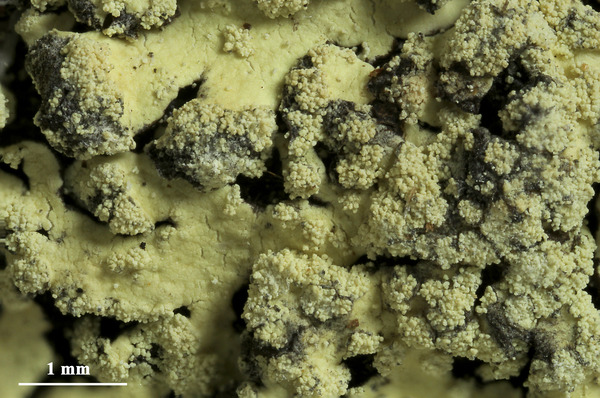

Felix Schumm - CC BY-SA 4.0
[19110], Australia, Victoria, Pretty Valley, Alpine National Park, 18 km south-south-east of Mt. Beauty, 36°53' S, 147°14' E, 1600 m, growing on base of dead Eucalyptus in open Eucalyptus pauciflora woodland with large granite outcrops. Leg. J.A. Elix (40630) & H. Streimann 18.02.1994.
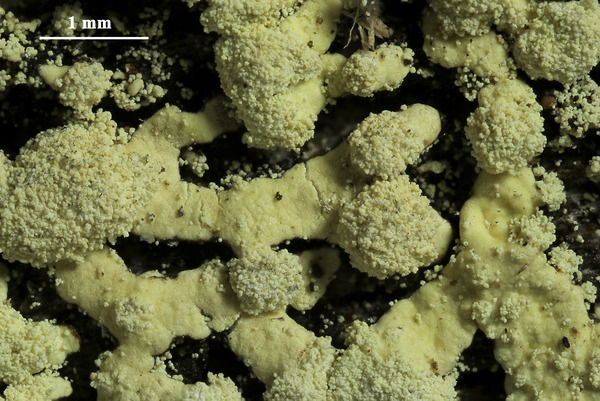

Felix Schumm - CC BY-SA 4.0
[19110], Australia, Victoria, Pretty Valley, Alpine National Park, 18 km south-south-east of Mt. Beauty, 36°53' S, 147°14' E, 1600 m, growing on base of dead Eucalyptus in open Eucalyptus pauciflora woodland with large granite outcrops. Leg. J.A. Elix (40630) & H. Streimann 18.02.1994.
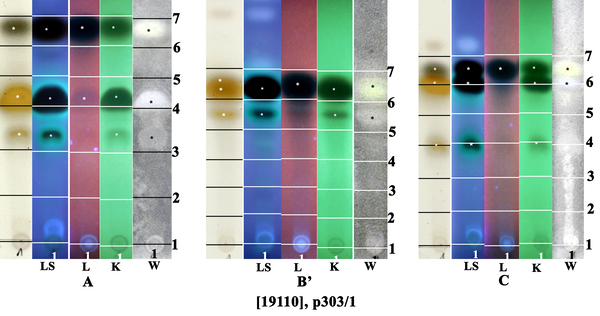

Felix Schumm - CC BY-SA 4.0
[19110], Australia, Victoria, Pretty Valley, Alpine National Park, 18 km south-south-east of Mt. Beauty, 36°53' S, 147°14' E, 1600 m, growing on base of dead Eucalyptus in open Eucalyptus pauciflora woodland with large granite outcrops. Leg. J.A. Elix (40630) & H. Streimann 18.02.1994.
us: usnic acid, div:divaricatic acid, nd: nordivaricatic acid
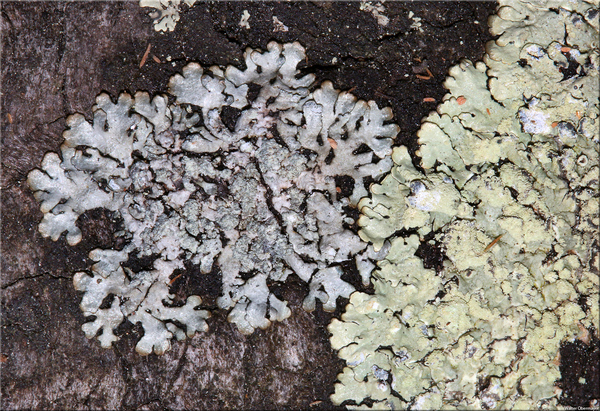
Walter Obermayer CC BY-SA 4.0 - Source: Lichens of Noricum - http://lichens-of-noricum.uni-graz.at/
with P. hyperopta (left)

Bernard Bouffinier - Source: http://www.lichensmaritimes.org/index.php?task=fiche&lichen=746&lang=en
France, Corse, Soccia

Bernard Bouffinier - Source: http://www.lichensmaritimes.org/index.php?task=fiche&lichen=746&lang=en
France, Corse, Soccia
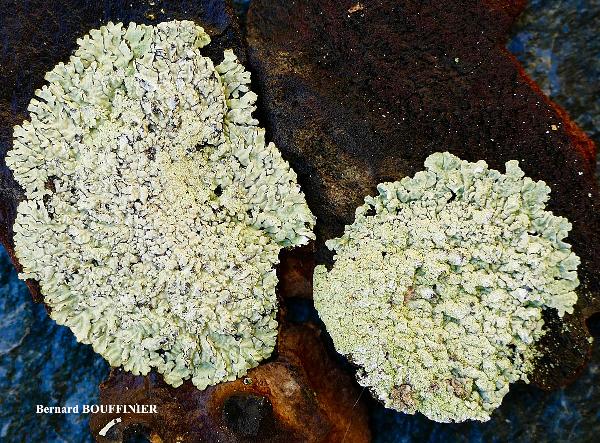
Bernard Bouffinier - Source: http://www.lichensmaritimes.org/index.php?task=fiche&lichen=746&lang=en
France, Corse, Soccia
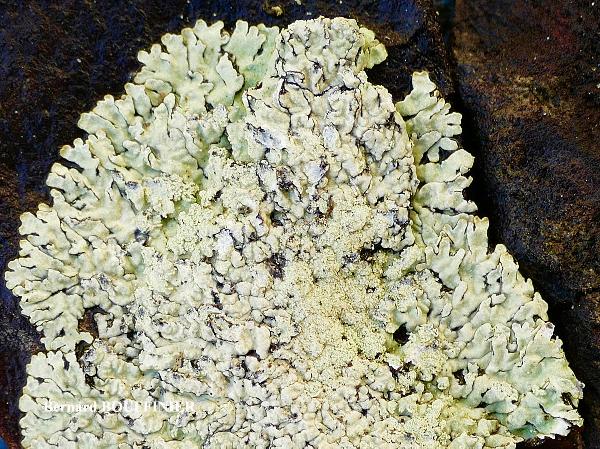
Bernard Bouffinier - Source: http://www.lichensmaritimes.org/index.php?task=fiche&lichen=746&lang=en
France, Corse, Soccia
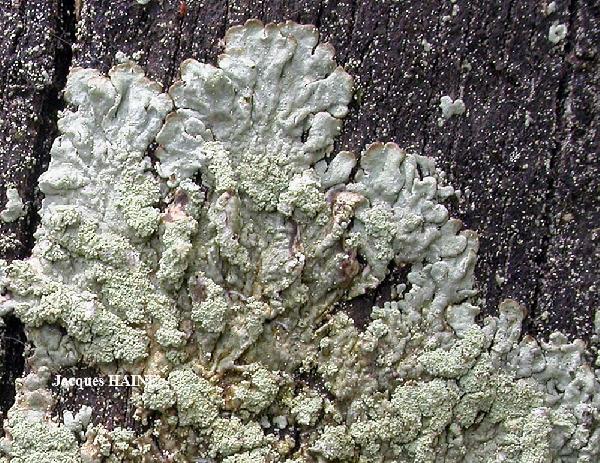
Jacques Haine - Source: http://www.lichensmaritimes.org/index.php?task=fiche&lichen=746&lang=en
France, Ardennes
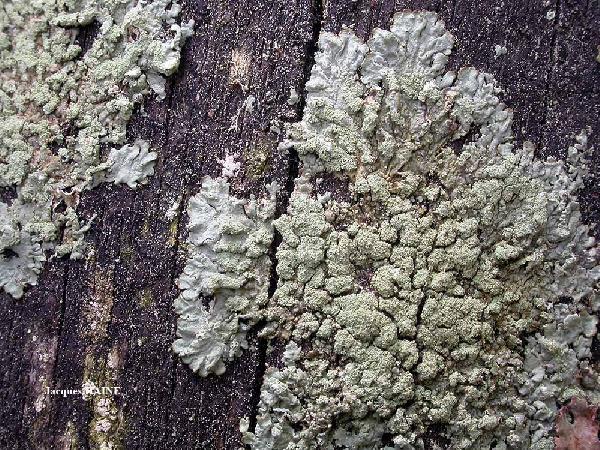
Jacques Haine - Source: http://www.lichensmaritimes.org/index.php?task=fiche&lichen=746&lang=en
France, Ardennes
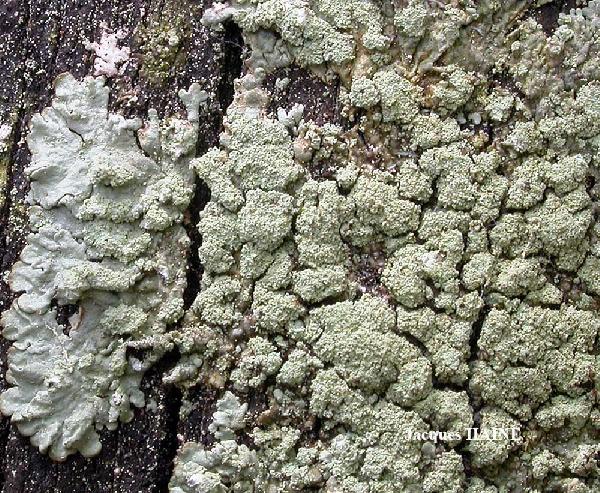
Jacques Haine - Source: http://www.lichensmaritimes.org/index.php?task=fiche&lichen=746&lang=en
France, Ardennes

Jacques Haine - Source: http://www.lichensmaritimes.org/index.php?task=fiche&lichen=746&lang=en
France, Mercantour
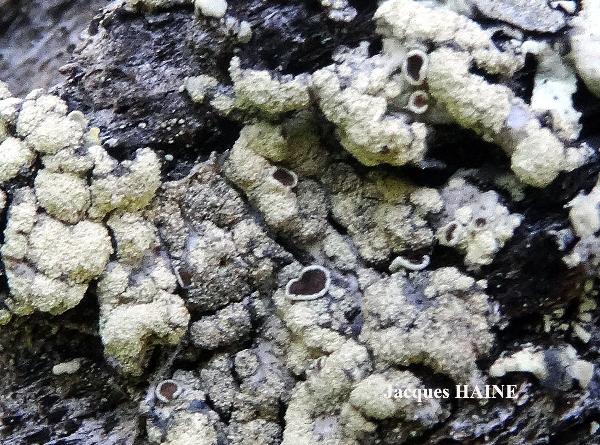
Jacques Haine - Source: http://www.lichensmaritimes.org/index.php?task=fiche&lichen=746&lang=en
France, Tarentaise
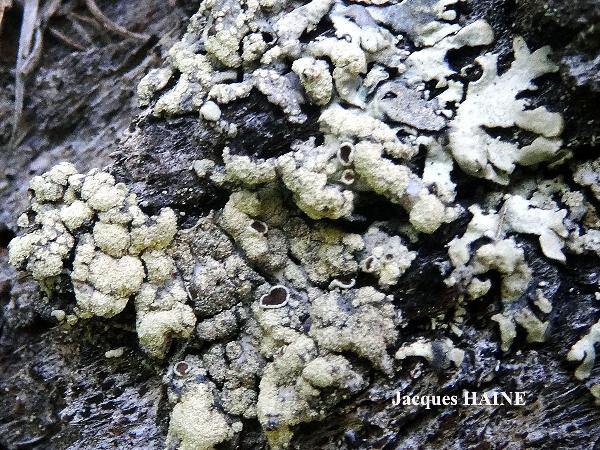
Jacques Haine - Source: http://www.lichensmaritimes.org/index.php?task=fiche&lichen=746&lang=en
France, Tarentaise
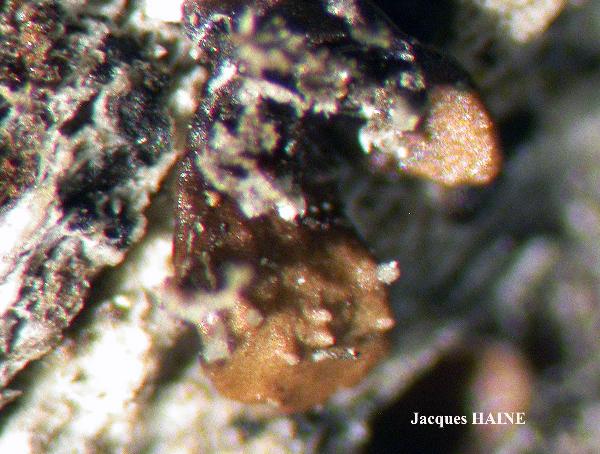
Jacques Haine - Source: http://www.lichensmaritimes.org/index.php?task=fiche&lichen=746&lang=en
France, Tarentaise
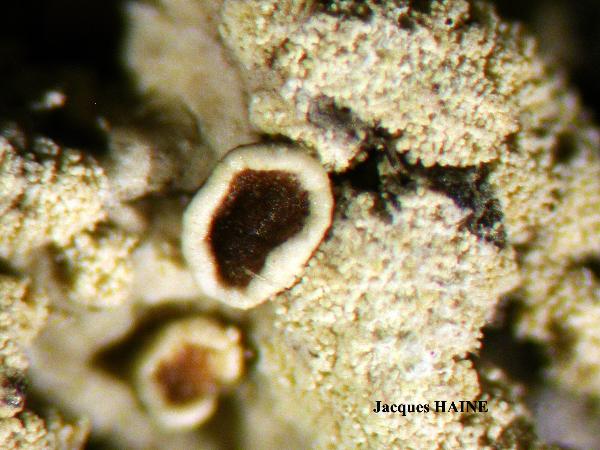
Jacques Haine - Source: http://www.lichensmaritimes.org/index.php?task=fiche&lichen=746&lang=en
France, Tarentaise

Jacques Haine - Source: http://www.lichensmaritimes.org/index.php?task=fiche&lichen=746&lang=en
France, Tarentaise

Jacques Haine - Source: http://www.lichensmaritimes.org/index.php?task=fiche&lichen=746&lang=en
France, Tarentaise
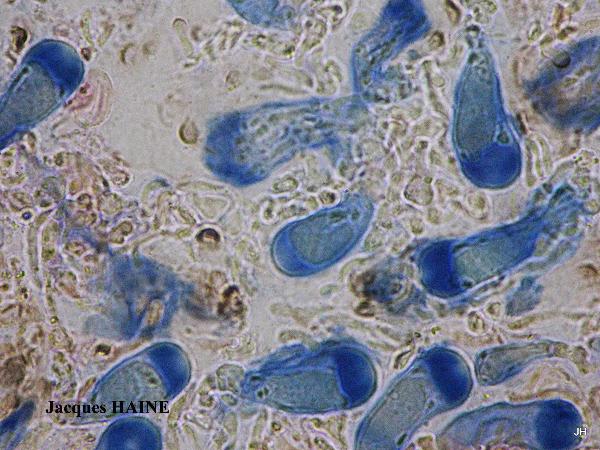
Jacques Haine - Source: http://www.lichensmaritimes.org/index.php?task=fiche&lichen=746&lang=en
France, Tarentaise
Growth form: Foliose, narrow lobed
Substrata: bark
Photobiont: green algae other than Trentepohlia
Reproductive strategy: mainly asexual, by soredia, or soredia-like structures (e.g. blastidia)
Commonnes-rarity: (info)
Alpine belt: extremely rare
Subalpine belt: extremely common
Oromediterranean belt: absent
Montane belt: rather rare
Submediterranean belt: extremely rare
Padanian area: absent
Humid submediterranean belt: extremely rare
Humid mediterranean belt: absent
Dry mediterranean belt: absent

Predictive model
| Herbarium samples |


P.L. Nimis; Owner: Department of Life Sciences, University of Trieste
Herbarium: TSB (33030)
2001/12/10
soralia


P.L. Nimis; Owner: Department of Life Sciences, University of Trieste
Italy, Friuli Venezia Giulia, Udine, Passo del Pura, Ampezzo Carnico, 1400 m
09.09.2016


P.L. Nimis; Owner: Department of Life Sciences, University of Trieste
Italy, Friuli Venezia Giulia, Udine, Passo del Pura, Ampezzo Carnico, 1400 m
09.09.2016


P.L. Nimis; Owner: Department of Life Sciences, University of Trieste
Herbarium: TSB (33030)
2001/12/10


Felix Schumm - CC BY-SA 4.0
[19110], Australia, Victoria, Pretty Valley, Alpine National Park, 18 km south-south-east of Mt. Beauty, 36°53' S, 147°14' E, 1600 m, growing on base of dead Eucalyptus in open Eucalyptus pauciflora woodland with large granite outcrops. Leg. J.A. Elix (40630) & H. Streimann 18.02.1994.


Felix Schumm - CC BY-SA 4.0
[19110], Australia, Victoria, Pretty Valley, Alpine National Park, 18 km south-south-east of Mt. Beauty, 36°53' S, 147°14' E, 1600 m, growing on base of dead Eucalyptus in open Eucalyptus pauciflora woodland with large granite outcrops. Leg. J.A. Elix (40630) & H. Streimann 18.02.1994.


Felix Schumm - CC BY-SA 4.0
[19110], Australia, Victoria, Pretty Valley, Alpine National Park, 18 km south-south-east of Mt. Beauty, 36°53' S, 147°14' E, 1600 m, growing on base of dead Eucalyptus in open Eucalyptus pauciflora woodland with large granite outcrops. Leg. J.A. Elix (40630) & H. Streimann 18.02.1994.


Felix Schumm - CC BY-SA 4.0
[19110], Australia, Victoria, Pretty Valley, Alpine National Park, 18 km south-south-east of Mt. Beauty, 36°53' S, 147°14' E, 1600 m, growing on base of dead Eucalyptus in open Eucalyptus pauciflora woodland with large granite outcrops. Leg. J.A. Elix (40630) & H. Streimann 18.02.1994.
us: usnic acid, div:divaricatic acid, nd: nordivaricatic acid

Walter Obermayer CC BY-SA 4.0 - Source: Lichens of Noricum - http://lichens-of-noricum.uni-graz.at/
with P. hyperopta (left)

Bernard Bouffinier - Source: http://www.lichensmaritimes.org/index.php?task=fiche&lichen=746&lang=en
France, Corse, Soccia

Bernard Bouffinier - Source: http://www.lichensmaritimes.org/index.php?task=fiche&lichen=746&lang=en
France, Corse, Soccia

Bernard Bouffinier - Source: http://www.lichensmaritimes.org/index.php?task=fiche&lichen=746&lang=en
France, Corse, Soccia

Bernard Bouffinier - Source: http://www.lichensmaritimes.org/index.php?task=fiche&lichen=746&lang=en
France, Corse, Soccia

Jacques Haine - Source: http://www.lichensmaritimes.org/index.php?task=fiche&lichen=746&lang=en
France, Ardennes

Jacques Haine - Source: http://www.lichensmaritimes.org/index.php?task=fiche&lichen=746&lang=en
France, Ardennes

Jacques Haine - Source: http://www.lichensmaritimes.org/index.php?task=fiche&lichen=746&lang=en
France, Ardennes

Jacques Haine - Source: http://www.lichensmaritimes.org/index.php?task=fiche&lichen=746&lang=en
France, Mercantour

Jacques Haine - Source: http://www.lichensmaritimes.org/index.php?task=fiche&lichen=746&lang=en
France, Tarentaise

Jacques Haine - Source: http://www.lichensmaritimes.org/index.php?task=fiche&lichen=746&lang=en
France, Tarentaise

Jacques Haine - Source: http://www.lichensmaritimes.org/index.php?task=fiche&lichen=746&lang=en
France, Tarentaise

Jacques Haine - Source: http://www.lichensmaritimes.org/index.php?task=fiche&lichen=746&lang=en
France, Tarentaise

Jacques Haine - Source: http://www.lichensmaritimes.org/index.php?task=fiche&lichen=746&lang=en
France, Tarentaise

Jacques Haine - Source: http://www.lichensmaritimes.org/index.php?task=fiche&lichen=746&lang=en
France, Tarentaise

 Index Fungorum
Index Fungorum
 GBIF
GBIF
